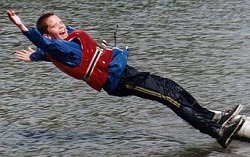Windsurfing
Windsurfing is a surface watersport that combines elements of surfing and sailing. A windsurfboard is usually 2 to 4 meters long, with a volume of about 60 to 250 liters, powered by wind on a sail.
The rig is connected to the board by a free-rotating universal joint and consists of a mast, 2-sided boom and sail. The sail area generally ranges from 2.5m2 to 12m2 depending on the conditions, the skill of the sailor and the type of windsurfing being undertaken.
Windsurfing can be said to straddle both the laid-back culture of surf sports and the more rules-based environment of sailing. Although it might be considered a minimalistic version of a sailboat, windsurfing offers experiences that are outside the scope of other sailing craft designs.
Extreme Sport
Windsurfers can perform jumps, inverted loops, spinning maneuvers, and other "freestyle" moves that cannot be matched by any sailboat. They were the first to ride the world's largest waves, such as Jaws on the island of Maui. It was not until the advent of tow-in surfing that waves of that size became accessible to surfers on more traditional surfboards.
Extreme waves aside, many expert windsurfers will ride the same waves as wavesurfers do (wind permitting) and are themselves usually very accomplished without a rig on a conventional surfboard.
At one time referred to as "surfing's ginger haired cousin" by the sport's legendary champion, Robby Naish, windsurfing has long struggled to present a coherent image of the sport to outsiders. As a result of attempts to claim the word "windsurfer" as a trademark, participants have been encouraged to use different names to describe the sport, including "sailboarding" and "boardsailing".
The term "windsurfing" has persisted as the accepted name for the sport, and the word "windsurfer" persists for both participants and equipment.
Windsurfing is predominately undertaken on a non-competitive basis.
Competitions
Organised competitions do take place at all levels across the world and typical formats for competitive windsurfing include Formula Windsurfing, speed sailing, slalom, course racing, wave sailing, superX, and freestyle.
These events are exciting to watch as sailors push the limits both physically and creatively with moves that look as impossible as thinking them up in the first place.
The boom of the 1980s led windsurfing to be recognized as an Olympic sport in 1984. However, windsurfing's popularity saw a sharp decline in the mid-1990s, thanks to licensing battles, and equipment becoming more specialized and requiring more expertise to sail. The sport experienced a modest revival, as new beginner-friendly designs became available.
However, starting in the 2000s, windsurfing began experiencing a decline in participation as many avid windsurfers took up the similar sport of kitesurfing.
Reader Story: Windsurfing Lessons
Story by Robin from Poole, UKLast summer I volunteered to teach windsurfing to a young group of absolute beginners. They've never been on a sailboard before. Each teacher looked after one or two students at a time, for about half an hour.
Dressed mostly in waterproof clothes or sportswear, like tracksuits and hoodies or anoraks, they kneeled nervously on their boards, paddling out onto the shallow lake.
Why are they so nervous?
It took me a while to work out why they were so nervous when standing up on their surfboards.
Turns out, they were afraid to fall in and get their clothes wet. So they were balancing nervously to stay dry. But windsurfing is a watersport and falling in is part of the fun.
What I needed was a fun method to get all their clothes wet before the lesson started.
Then they could relax.
So I asked them if they wanted a special treat and a secret that will give them confidence when standing up.
Of course they wanted to know.
Special Treat
At the beginning of each session, when they were still dry, I asked each of them if they like swimming in their clothes, or wanted to find out what it is like. Most did.
The secret was to stand up straight and lean back until they fall in, like it often happens when windsurfing. Falling in fully clothed is fun and builds confidence.
Some hesitated, looking at their dry clothes, but then leaned back and fell in with a mighty splash. They usually came up with a big smile and did it again a few times, just for fun. Once all their clothes were soaking wet, they were no longer afraid to fall in. That little exercise gave them the confidence they needed.
From then on they picked up windsurfing quickly. At the end of the session many asked if they can practice the falling in a few more times. They really enjoyed the rare treat of swimming fully clothed. It was always a good laugh.

Get your clothes wet first.

You'll be more confident, no longer nervous about falling in.